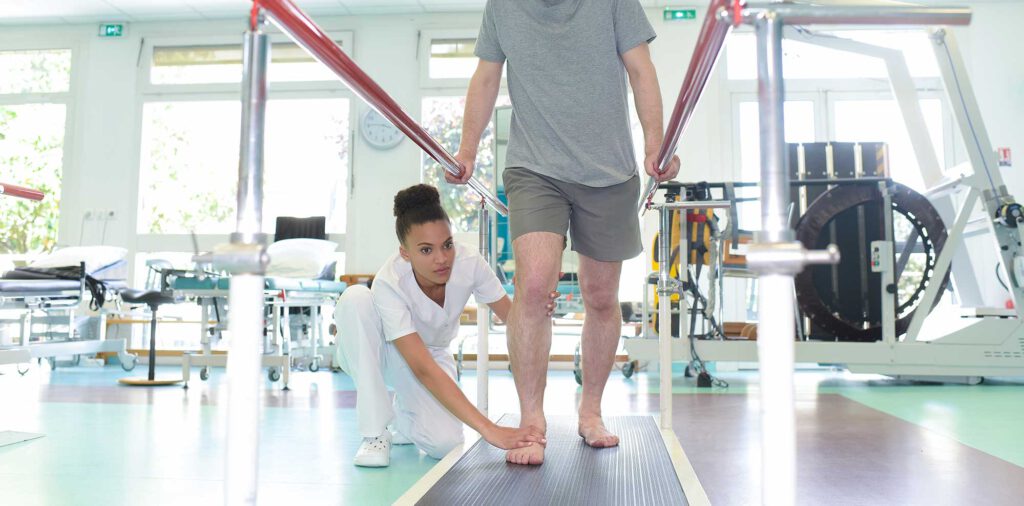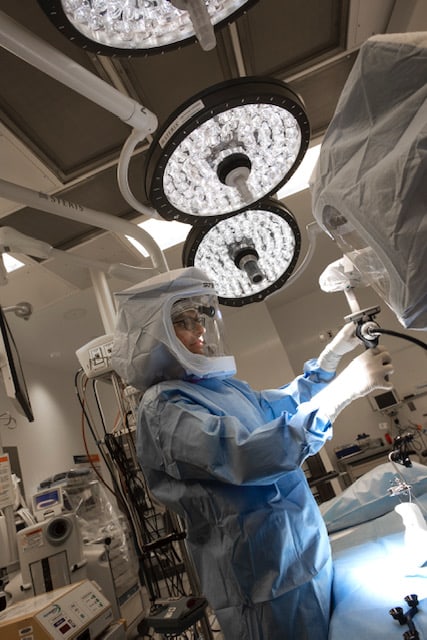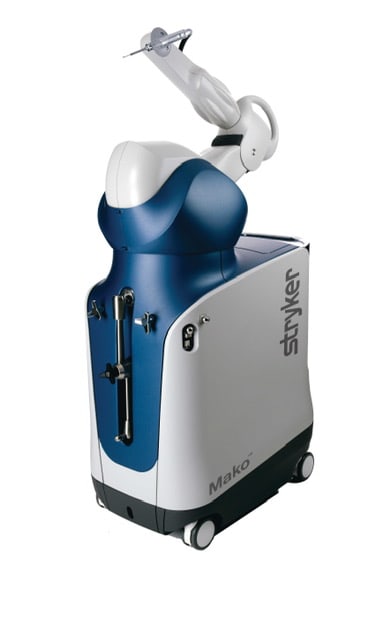
THE MAKO ROBOTIC ASSISTED DEVICE
This column is a monthly feature of “Health & Exercise Forum” in association with the students and faculty of Geisinger Commonwealth School of Medicine.
GUEST AUTHOR: JOHN MERCURI, MD, MA; Orthopedic Surgery - Adult Reconstruction; Geisinger Orthopaedics and Sports Medicine; Clinical Assistant Professor at Geisinger Commonwealth School of Medicine

According to John Mercuri, MD, a local orthopedic surgeon specializing in joint replacement and certified MAKO Robotic Assisted Hip & Knee Replacement surgeon, there are new advances in hip & knee replacement surgery which offers significant benefits to the patients of Northeastern Pennsylvania
WHAT IS ROBOTIC ASSISTED JOINT REPLACEMENT SURGERY?
In the past few years you may have heard or read about the relatively new concept of “robotic surgery.” Often, people get the wrong impression and think that the surgery is performed by a robot in place of a surgeon. But in fact, a surgeon performs the procedure, with the assistance of a robot.
In 2000, the Food and Drug Administration approved the da Vinci Surgical System, the first widely used surgical robot in the United States. Named after the famous inventor who tirelessly studied human anatomy, the device is designed to facilitate surgery using a minimally invasive approach while the surgeon operates from a console. The da Vinci has been successfully used on prostate, cardiac and gynecological surgeries and continues to offer many advantages to surgery.
In 2006, another robotic system was launched specifically for orthopedic surgery. It is called the MAKO Robotic Arm Interactive Orthopaedic System, and it is currently owned by Stryker Corporation. It was initially used to perform a partial knee replacement, but has since been used for more than 83,000 total hip and knee replacements with 980 active surgeon users.
The MAKO system involves the use of a CT scan before surgery to create a 3-D virtual model of the unique anatomy of the joint. The model is programmed into the MAKO system software and used by the surgeon to help customize a joint replacement specifically designed for the patient’s unique anatomy.
During surgery, the surgeon uses the MAKO system to tweak the plan and perform the surgery. Using the predefined area set by the CT scan, the surgeon guides the robotic arm to remove the arthritic portions of bone and cartilage and then the surgeon uses the robot to insert a custom-fit and aligned partial or total implant. The robotic system helps the surgeon stay inside the planned boundaries to provide 99 percent accuracy and alignment of the new joint.
Locally, John J. Mercuri, MD, orthopedic surgeon at Geisinger Orthopedics and Sports Medicine, is trained and certified to use the MAKO system. He performs hip and knee replacements at Geisinger Community Medical Center and uses the MAKO system whenever appropriate. He feels that robotic technology can help eliminate some of the common problems associated with joint replacements including dislocations, instability, and implant failures. It can also help the surgeon perform a more efficient, faster, and less invasive surgery.
Last week, we interviewed Bob from West Mountain who shared his MAKO success story. His second knee was replaced using MAKO 6 months ago and he boasts that he is functioning at 90%.
TRADITIONAL VS. ROBOTIC ASSISTED JOINT ARTHROPLASTY (REPLACEMENT)
Traditional Joint Replacement
By surgically replacing the arthritic ends of bones with metal and plastic components, a hip or knee replacement creates new surfaces to allow a joint to function like a natural joint without the pain and restriction of a damaged, degenerative arthritic hip or knee.
A total hip or knee replacement (THR or TKR), also called a total hip or knee arthroplasty (THA or TKA), resurfaces the compartments of the hip or knee joint while attempting to preserve most of the surrounding supporting soft tissues. In the knee, a total joint replacement is required if cartilage (thick cushion covering ends of bones) in all three compartments is damaged/worn away resulting in arthritis. For those with arthritis and degeneration in only one compartment, usually the medial or inside compartment, a partial knee replacement, also called a unicompartment knee arthroplasy (UKA) may be a better choice, especially for those who are relatively young and active.
Traditional joint replacements have held up to the test of time. Copious amounts of research support their effectiveness, and many studies show that 80-90% of total knee replacements last at least 20 years (and even longer for hip replacements).
However, there are a variety of reasons that a joint replacement may not last as planned. Revision surgery to correct the problem can be complicated and have a lengthy recovery process. Fortunately, new robotic technologies can help eliminate some of the problems that lead to early revision surgery.
Robotic Joint Replacement
Robotic assisted joint replacement begins with a CT scan of the effected joint. Using the predefined area set by the scan, the surgeon guides the robotic arm to remove the arthritic portions of bone and cartilage, and then the surgeon uses the robot to insert the implants in a very precise position. The robotic system helps the surgeon stay inside the planned boundaries to provide 99 percent accuracy and alignment of the new joint.
Historically, some of the leading experts in knee replacement surgery realized that misalignment or instability of a knee replacement can lead to early failure rates. More recent research on hip replacement has shown that incorrectly placed components can lead to dislocation of the hip and early failure of the joint. It is based on this premise that robotic assisted joint replacements have been developed. They use technology to assist in better implant placement to minimize complications and increase implant longevity.
According to American Academy of Orthopaedic Surgeons (AAOS), “preliminary data show robotic-arm assisted TKA is safe and effective, with outcomes comparable to, if not better than, those of manually-instrumented TKA.”
Qualifications for a Robotic Assist
The qualifications for a robotic are the same as a traditional TKA in terms of pain with loss of function. However, robotic surgery may be especially beneficial for patients with congenital joint problems, someone who has had prior surgery in the joint, patients who have had a traumatic injury to the joint, or patients who have spine arthritis but also need joint replacement. Regardless of whether you have a joint replacement with or without a robot, there are multiple factors that are used to determine whether surgery is safe for you including your medical history and your current overall health.


Advantages of a Robotic Assist
When appropriate patients are selected and proper surgical technique performed, several studies have determined that the robotic assist is a viable and successful option. One study found as many as 92% of robotic assist patients had excellent or good outcomes. Additionally, the study found a 96% implant longevity rate with patients reporting a more natural and quieter knee, especially in those patients suffering from bone deformities or previous traumas to the joint. Other studies found that the potential advantages are many:
Complications of Robotic joint replacement surgery
While less frequent, robotic complications are similar to those found in traditional joint replacements. Those complications most commonly include infections, blood clots, and fractures. However, robotic surgery is unique in that there is the possibility of a complication related to the placement of metal pins into your bone during the surgery. These metal pins are necessary for the robot to “see” where your bones are during the surgical procedure.
In summary, while the idea of getting a joint replacement (robotic or traditional) is intimidating, it is one of the safest and most effective medical procedures! The fact that the robotic technology can further advance an already successful operation is very exciting! Discuss which option is best for you with your orthopaedic surgeon. NEPA is fortunate to have many highly skilled and experienced board- certified orthopedic surgeons successfully performing joint replacements daily. For more information, and to find out who is performing robotic assisted joint replacements in your area, visit our source for this column, the American Academy of Orthopaedic Surgeons website: www.aaos.org
SOURCES: Rothman Institute, Philadelphia, PA; American Academy of Orthopaedic Surgeons, Stryker Corporation, Geisinger Orthopedics and Sports Medicine
For More Information: aaos.com; stryker.com; YouTube MAKO Robotic Joint Replacement
Medical Contributor: John J Mercuri, MD, MA; Orthopedic Surgery - Adult Reconstruction; Geisinger Orthopaedics and Sports Medicine; Clinical Assistant Professor at Geisinger Commonwealth School of Medicine
Visit your doctor regularly and listen to your body.
NEXT MONDAY – Read Dr. Paul J. Mackarey “Health & Exercise Forum!”
This article is not intended as a substitute for medical treatment. If you have questions related to your medical condition, please contact your family physician. For further inquires related to this topic email: drpmackarey@msn.com
Paul J. Mackarey PT, DHSc, OCS is a Doctor in Health Sciences specializing in orthopaedic and sports physical therapy. Dr. Mackarey is in private practice and is an associate professor of clinical medicine at GCSOM.